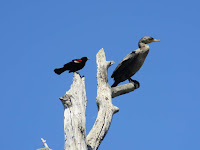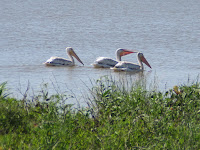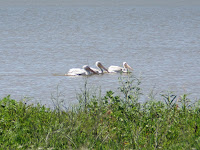This weekend's trip to Hagerman was much hotter than the last. Texas is well into summer already and the temperature was in the upper 90s with almost no clouds in the sky. Along with the uptick in the temperature, there were fewer wildflowers and more "brown stuff" in the landscape. Still beautiful though.


Around the water, the grasses and reeds have gotten a lot taller. Everything is a vibrantly green to the point that it's almost difficult to focus on anything.




On this visit, we actually saw quite a few boats, including a sailboat. Unfortunately, the air was pretty hazy. North Texas has had a lot of "ozone action days" so far this summer.

Insects
Even with the heat, there were a lot of insects. Many were the "annoying" kind that bite (like flies and mosquitoes), but there were also a lot of friendlier pollinators like bees, moths, and butterflies. I think this photo is of a Mexican Fritillary (Euptoieta hegesia):

Juvenile waterbirds
The babies we saw last month have gotten a bit bigger. The Canada goslings were easier to take photos of than the juvenile mallard ducks. Although the ducks were much closer to us, they kept very near the brush along the shore line. And when they thought we were too close, they doubled back, hopped out of the water, and crossed the road behind our car to get to the other side of the water!



We saw a lot more birds than I expected. With the weather so hot and us being there in the afternoon, I thought that we'd see a few blackbirds and egrets and that would be it.
Red-winged blackbird
There were plenty of blackbirds around and most of them were getting very territorial. Weren't able to get any clear pictures of it, but we saw a couple of blackbirds fighting with an egret; I assume the egret got too close to where the birds were nesting.

Juvenile Bald Eagle
This is was super exciting for me -- I've never seen a bald eagle in the wild so close up before. This juvenile was perched on top of an old telephone(?) pole. At first, I thought the dark "blob" was just a control box or something. As I watched, the "blob" moved and I thought it might be a vulture of some sort. The sun was extremely harsh, so it was hard to make out any details. We drove up really close to the pole and, once I saw its beak, I realized it was an eagle. (It wasn't until I checked my birding guide later that I realized it was a juvenile bald eagle.) This bird was very interested in watching things, but not particularly interested in watching us.


Roadrunner
Another exciting sighting was this roadrunner. It ran across the road (literally) in front of us and flew into a bush where it patiently waited while I snapped a few photos.





































































